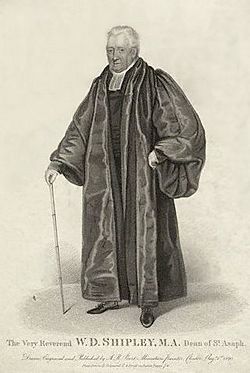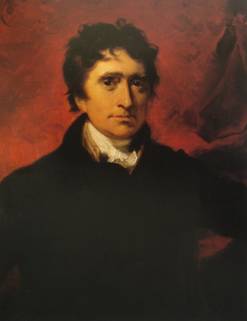Case of the Dean of St Asaph facts for kids
Quick facts for kids R v Shipley |
|
|---|---|

William Davies Shipley, the defendant
|
|
| Court | King's Bench |
| Full case name | Rex versus (or the Crown and/against) The Venerable William Davies Shipley |
| Decided | 22 November 1784 |
| Citation(s) | (1784) 4 Doug 73 |
| Court membership | |
| Judge(s) sitting | Lord Mansfield Willes J Ashurst J |
The Case of the Dean of St Asaph, officially known as R v Shipley, was an important court case in 1784. It involved William Davies Shipley, a church leader known as the Dean of St Asaph. He was accused of seditious libel, which meant publishing something that criticized the government and could cause unrest.
This happened after the American War of Independence, when many people in Britain wanted to change how Parliament worked. William Pitt the Younger tried to make these changes. To support this, Shipley republished a pamphlet written by his brother-in-law, Sir William Jones. The pamphlet talked about problems with the old system and supported Pitt's ideas.
However, Thomas FitzMaurice accused Shipley of seditious libel. This law was often used by the government to stop criticism. Under this law, a jury could not decide if the published material was actually harmful. They could only decide if the person had published it. Many people thought this law was unfair. A group called the Society for Constitutional Information was formed to help Shipley. They paid for his legal costs, allowing him to hire Thomas Erskine, a famous lawyer.
Shipley's trial took place in 1784. The jury first gave a confusing verdict: "guilty of publication only." The judge, Mr Justice Buller, eventually said this meant Shipley was guilty of all charges. Erskine appealed this decision. The higher court agreed that juries could not decide if something was libel. However, Shipley was set free because of a small legal mistake in his original accusation. People celebrated his freedom with fireworks. Erskine continued to work for change. Thanks to his efforts, the Libel Act 1792 was passed. This law finally gave juries the right to decide if published material was truly libel.
Contents
Why the Case Happened
After the American War of Independence ended, people in Britain started focusing on fixing their own government. Many towns didn't have the right to vote, and some areas called "rotten boroughs" had very few voters but still had a lot of power in Parliament.
William Pitt the Younger wanted to change this. To support his ideas, Sir William Jones wrote a pamphlet. It was called A Dialogue between a Farmer and a Country Gentleman on the Principles of Government. This pamphlet talked about good government and how people weren't properly represented in Parliament.
In 1783, Shipley, who was Jones's brother-in-law, liked the pamphlet. He recommended it to a group of Welsh reformers and had it printed in Welsh. He added his own introduction, saying the pamphlet was "just, rational and constitutional." Because of this, Thomas FitzMaurice accused Shipley of seditious libel. He claimed Shipley was "publishing a false, scandalous and malicious libel... to raise seditions and tumults within the kingdom." This meant FitzMaurice thought Shipley was trying to cause trouble and rebellion.
Understanding Seditious Libel
The law about seditious libel was very strict back then. It was the government's main way to stop people from criticizing them. Here's how it worked:
- Publishing something critical of the government was a crime.
- It didn't matter if the publisher meant to cause harm or if what they said was true.
- Just publishing the material was enough for a conviction.
- Juries were only allowed to decide if the person had published the material. They were not allowed to decide if the material was actually libel (harmful or rebellious).
Normally, juries decide facts and judges decide law. But with seditious libel, the judges decided almost everything. They decided what counted as "seditious libel" and what "publication" meant. Even a private letter, if found, could lead to a charge.
Many people felt this law was unfair. So, Shipley's trial became a "test case" to challenge it. A group called the Society for Constitutional Information was formed. They raised money to pay for Shipley's defense. This allowed them to hire Thomas Erskine, a well-known defense lawyer.
The trial was first supposed to be heard in Wrexham. But Erskine found out that a paper was being passed around saying juries could decide if a publication was libel. The prosecution used this to ask for a delay. The judge agreed, even though it caused problems for Shipley. The case finally went to trial on 6 August 1784, in Shrewsbury.
The Trial and Appeal
Edward Bearcroft, the lawyer for the prosecution, said that the Dialogue pamphlet was libel. He argued that the jury didn't need to decide if it was true or not. He said they just had to decide if Shipley had published it. Bearcroft claimed the pamphlet tried to convince people that "every man of age had a right to choose his own representative in Parliament."
Erskine, Shipley's lawyer, argued that the Dialogue was not libel. He pointed out that it started with a statement against all rebellion. He strongly believed that the jury had the right to decide what counted as libel. He said:
If they know that the subject of the paper is the topic that agitates the country around them; if they see danger in that agitation, and have reason to think that the publisher must have intended it, they say he is guilty. If, on the other hand, they consider the paper to be legal and enlightening in principle; likely to promote a spirit of activity and liberty, in times when the activity of such a spirit is essential to the public safety, and have reason to believe it to be written and published in that spirit; they say, as they ought to do, that the writer or the publisher is not guilty.
To show how strongly he felt, Erskine said he would publish the pamphlet himself. He then went through the Dialogue line by line. He showed that most people would agree with it. He also showed that it was the basis for Pitt's plan to reform Parliament. Erskine finished by saying the jury should feel free to decide if the material was libel.
However, the judge, Mr Justice Buller, told the jury they could only decide if Shipley had published the work. The jury discussed it for half an hour. They came back and said Shipley was "guilty of publishing only." After a confusing discussion between Erskine, Buller, and the jury, Buller declared Shipley guilty of all charges.
Erskine immediately appealed the decision to a higher court, the Court of King's Bench. On 8 November, he argued that Buller's instructions had misled the jury. He said that since juries weren't allowed to decide Shipley's actual guilt, the first trial was unfair. He argued that a jury should be allowed to decide if a statement was published and if it was libel.
Most of the judges in the King's Bench disagreed with Erskine. They said juries did not have that role. So, his appeal was denied. However, Shipley was later set free. This was because the King's Bench found a technical error. The original accusation against him was not properly written. It didn't clearly show how the pamphlet was a libel against the king and government.
Lord Mansfield, a main judge in the case, worried that Erskine's ideas would cause problems. If every jury could define 'libel' differently, the law could become chaotic. Erskine had tried to address this. He argued that the trial judge should guide the jury on the law of seditious libel. This way, the jury could give a full verdict on guilt, while still respecting the judge's legal knowledge.
This debate about the jury's role became very important. It influenced discussions about juries in America in the 1800s.
What Happened Next
Even though the case didn't immediately change the law, it was seen as a big win. When Shipley was released, people celebrated with fireworks and bonfires. Erskine was honored with the Freedom of the City of Gloucester.
Erskine, however, knew more work was needed. He had records of the entire trial printed. He sent them to important politicians like Charles James Fox and Lord Camden. Fox took the hint and, after some time, introduced a new law to Parliament in May 1791. This law aimed to change the libel law.
The new law passed in the House of Commons. Then it went to the House of Lords. Some judges there tried to stop it. But Lord Camden, who was 78 years old, spoke up. He said that if judges were the only ones to decide what public opinion was, then nothing critical of the government could ever be published. This would stop the freedom of the press. His speech was very powerful. Historians say the law would not have passed without it. Within three weeks, Parliament officially passed the Libel Act 1792. This law, also known as Fox's Libel Act, finally gave juries the power to decide exactly what counted as libel.
Images for kids



